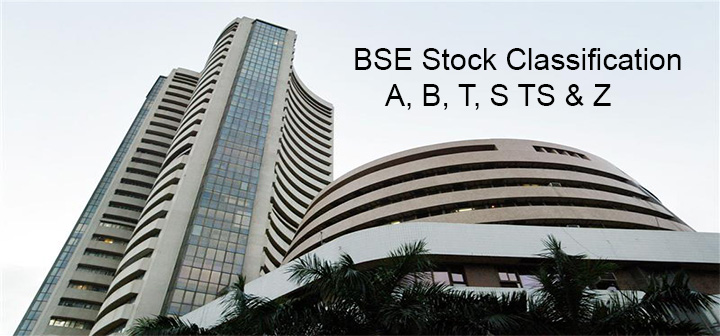
Published : June 5, 2019

Stock classification is the process of grouping stocks for ease of understanding. In India both BSE (Bombay Stock Exchange) and NSE (National Stock Exchange) classifies stocks. More or less the classification of stocks is similar on both platforms.
This stock classification was done to handle the stocks based on trading characteristics of Indian shares on the exchange platform and are known as grades. Mainly there are seven grades of stocks namely, A, B, T, S, TS & Z. All other stocks which fail the characteristics of any one of these grades were kept in others. These grades are scores of stocks on the basis of their size, liquidity and exchange compliance. Moreover, you will also reason yourself for any of your’s such decisions.
In the following section, I will discuss the main characteristics of various stock classification in India. This will help you in understanding whether you should invest in any one of these categories and hold for how much time. Whether you need to hold an ‘A’ category in your long term portfolio or you need to avoid ‘Z’ category stocks, all you will understand properly.
Besides these groups, the exchange has also some other method of stock classification. One such stock classification refers to the SLB group. Further, based on the market capitalization of companies, the exchange had also classified the listed company’s stocks, viz. large, mid and small cap stocks.
The short form of market capitalization is ‘market cap’ or ‘m-cap’. It refers to the total monetary value of the outstanding shares of any company in the market at any point in time. The formula for calculating M-cap is multiplying the price of each share of a company by the total number of issued shares. Further discussions cover this.
It is important to note that both BSE and NSE have their own way to group listed stocks. These classifications serve a particular purpose to both the exchange and the investors. The NSE classification gives you a sense of volume for the stocks. On the other hand, the BSE stocks classification helps you in two ways. It not only helps in determining liquidity but also segregates on the detailed quality of the stocks. However, the grouping of stocks on the basis of market capitalization is a sort of universal method of classifying stocks.

Enjoy flexible trading limits at
lowest brokerage rates ?
Open Your Investments Account Now
0Account Opening Charges
Life Time Demat AMC
Brokerage







Ensure the security of your investments by updating your nominee details in your trading & demat account online. It’s quick and hassle-free!
📌 Act Now to Stay Compliant
For assistance, contact our Customer Care at 0562‑4266666 and email askus@rmoneyindia.com.

IT'S TIME TO HAVE SOME FUN!
Your family deserves this time more than we do.
Share happiness with your family today & come back soon. We will be right here.
Investment to ek bahana hai,
humein to khushiyon ko badhana hai.
E-mail
askus@rmoneyindia.com
Customer Care
+91-9568654321